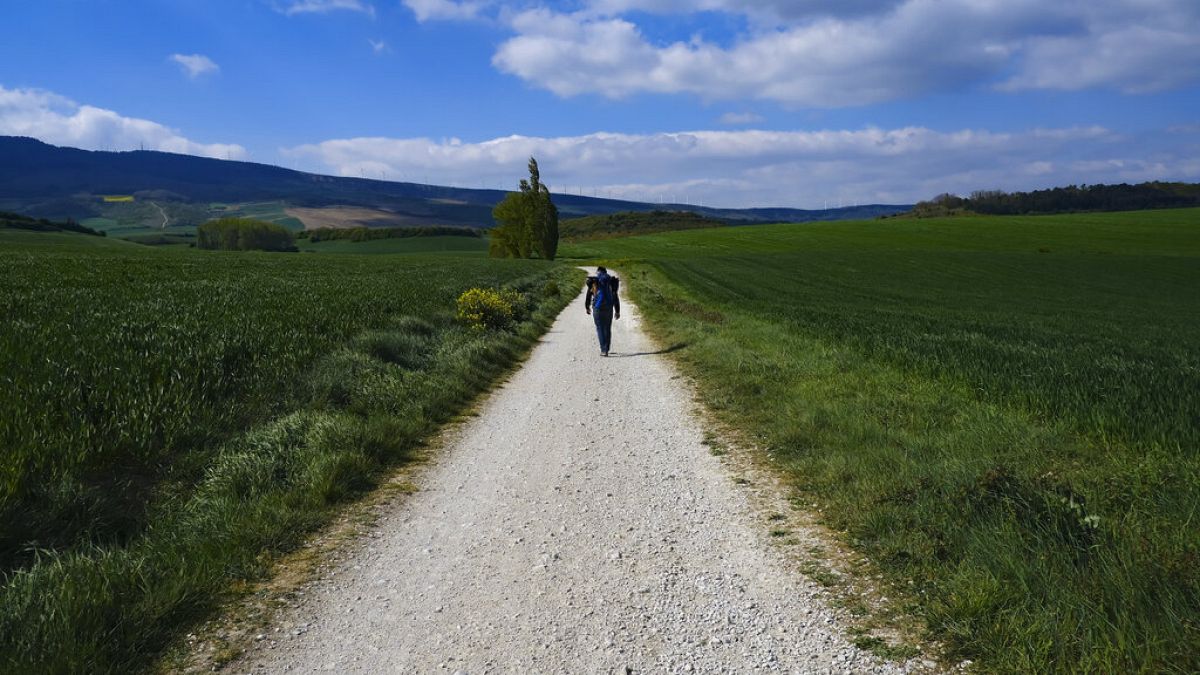Committing to the pilgrim's path has for centuries been a source of renewal for those willing to put their lives on hold and seek spiritual healing.
Pilgrims are trickling back to Spain's St. James Way after a year of being kept off the trail due to the pandemic.
Taking the pilgrim's path across Spain can take days, weeks, or even months to reach the medieval cathedral in Santiago de Compostela.
But now pilgrims are once again strapping on backpacks and following the route marked by the seashell emblem to heal wounds left by the coronavirus.
Some need solace after losing loved ones, a job, or a marriage. Others stride to enjoy the freedom they had taken for granted until the health crisis put limits on them.
'Unburden yourself'
Laura Ferrón and her friends are on a climb near the village of Arzúa, two days from Santiago in the green hills of northwest Spain.
Ferrón's marriage ended during the lockdown and she is now afraid that she could be fired as part of a massive layoff announced by the bank she works for.
If she loses her job, she will join the hundreds of thousands of Spaniards who have become unemployed due to the economic slump caused by the health crisis.
"You unburden yourself, let go of what is negative inside you, think, start thinking and you give things a little more value, the fact is that the pandemic has taught us to give more value to important things," she says.
Desperate for relief, Ferrón and two lifelong friends, Maria del Mar Espinosa and Carmen Hidalgo flew from their homes in Spain's north Africa enclave of Ceuta to spend a week walking the final 100 kilometres of the "Camino de Santiago."
"You get away from the routine, you get more time to think about things, because the routines don't allow you to think," says Hidalgo.
"You can let your mind wander, you lose yourself," adds del Mar Espinosa.
When the pandemic hit Spain in March 2020, the country applied lockdown measures that drastically reduced travel.
The St. James' Way drew more than 340,000 walkers from all over the world in 2019. Only 50,000 walked it last year, mostly during the summer months when Spain briefly relaxed its restrictions.
Before Spain's state of emergency that limited travel between regions ended on May 9, only a handful of pilgrims were arriving at Santiago each day and registering with the Pilgrims' Office to receive their certificate for completing the pilgrimage.
In recent weeks authorities have removed most limitations on travel with Spain's vaccination programme picking up speed.
A small trickle of pilgrims has begun, even though many hostels that cater to them are still closed.
A few hundred arrive at Santiago each day, compared to the several thousand during the summer months when Santiago is flooded by exhausted pilgrims swinging their walking sticks over its cobblestone streets.
Natuca Mansoa is doing the Camino with her sister and elderly parents.
"So they are very old, he is 84 years old, she is 81, they are both now vaccinated. We are travelling together," she says.
"It seemed to us to be a precious, precious experience, to be able to repeat now that they are vaccinated, as is my sister because she works in health care and I have passed it. So, we had to take advantage of their last years. And it's great that they can enjoy it, and especially as a family together. "
For many pilgrims forced away from their families at the start of the pandemic, the Camino is an opportunity for them to reunite as well as give thanks for being together once again.
"We really wanted to do something all together as a family. The whole family is healthy and we wanted to thank the Saint a little bit for the luck we have had," says pilgrim Montserrat Busquets.
The St. James Way is actually a series of paths that fan out beyond the Iberian Peninsula and spread across Europe.
But whichever route you take, they all end at Santiago's baroque cathedral where believers can visit the tomb of James the Apostle, who, according to Catholic tradition, brought Christianity to Spain and Portugal.
